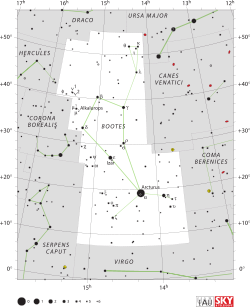梗河一
梗河一(ε Boötis,缩写Epsilon Boo或ε Boo),官方的正式名称为 Izar /ˈaɪzɑːr/[13],是在北天星座牧夫座中的一颗联星。这颗恒星可以直接以裸眼看见,但对76 mm(3.0英寸)的望远镜要解析出是联星,却很有挑战性,而通常需要口径更大的望远镜[14]。
| 观测资料 历元 J2000 | |
|---|---|
| 星座 | 牧夫座 |
| 星官 | 梗河(氐宿) |
| 赤经 | 14h 44m 59.21746s[1] |
| 赤纬 | +27° 04′ 27.2099″[1] |
| 视星等(V) | 2.70[2] / 5.12[3] |
| 特性 | |
| 光谱分类 | K0 II-III[4] + A2 V[5] |
| U−B 色指数 | +0.73[2] |
| B−V 色指数 | +0.97[2] |
| 天体测定 | |
| 径向速度 (Rv) | −16.31[6] km/s |
| 自行 (μ) | 赤经:−50.95[1] mas/yr 赤纬:+21.07[1] mas/yr |
| 视差 (π) | 16.10 ± 0.66[1] mas |
| 距离 | 203 ± 8 ly (62 ± 3 pc) |
| 绝对星等 (MV) | −1.61[7] |
| 详细资料 | |
| A | |
| 质量 | 4.6[8] M☉ |
| 半径 | 33[6] R☉ |
| 表面重力 (log g) | 2.2[6] |
| 亮度 | 501[6] L☉ |
| 温度 | 4,550[6] K |
| 金属量 | –0.13[6] |
| 自转速度 (v sin i) | 10.9[6] km/s |
| 年龄 | 37.4 ± 4.2[9] Myr |
| B | |
| 自转速度 (v sin i) | 123[10] km/s |
| 其他命名 | |
| 参考数据库 | |
| SIMBAD | 资料 |
命名
编辑它的传统名称是Izar、Mirak和Mizar,还有奥图·史都华命名的Pulcherrima /pəlˈkɛrɪmə/[15];Izar、Mirak和Mizar源自阿拉伯的 إزار ’izār 'veil' 和المراق al-maraqq 'the loins';'Pulcherrima' 是拉丁文的 '可爱'[16]。在2016年,国际天文学联合会组织的IAU恒星名称工作组(WGSN)[17]开始对恒星的名称进行编目和标准化。WGSN于2016年8月21日核定梗河一的名称为Izar,现在已经输入IAU的星名目录中[13]。
在Calendarium of Al Achsasi Al Mouakket这本古老的恒星目录中,这颗恒星被标志为Mintek al Aoua (منطقة العوّاء - minṭáqa al awwa);翻译成拉丁文是Cingulum Latratoris,意思是博克的腰带[18]。
在汉语,梗河一(Gěng Hé yī)的意思是氐宿中的星官梗河的第一颗星。这个星官共有三颗恒星,另外两颗是牧夫座σ和牧夫座ρ[19][20]。
性质
编辑梗河一由两颗恒星组成,其角距离为2.852 ± 0.014 弧秒,方位角342.°9 ± 0.°3[21]。较亮的恒星(A)视星等为2.70等,[2],在夜晚很容易以裸眼看见。较暗的那一颗(B)视星等为5.12等[3],理论上应该也可以用裸眼看见。依巴谷天体测量卫星[22][23]测量其视差,得到它与地球的距离大约是203光年(62秒差距)[1]。这意味着这两颗星之间的投影分离度大约是185天文单位,互绕的轨道周期至少是1,000年[16]。
较亮的梗河一A光谱类型为K0 II-III[4],意味着它是一颗相当年长的恒星,在恒星演化的路途上已经耗尽了核心的氢燃料。有着超过太阳4倍的质量[8],它的半径已经扩展至33倍太阳半径,而估计其光度是太阳亮度的501倍[6],在表面有效温度4,550K向外辐射的能量[6]使它呈现出K型恒星的橙色[24]。
伴星的光谱类型为A2 V[5],所以它是一颗核心仍在进行核聚变,将氢融合成氦的主序星。这颗恒星自转的非常快,投影的自转速度是123 km s−1[10],当质量较低的主序星在其演化过程中达到目前生命的关键点时,质量较大的恒星会失去较多的质量成为行星状星云,残留的核心则演化成为白矮星。这对组合基本上将改变角色:原本明亮的恒星将成为黯淡的侏儒,而较小的伴星将成为明亮的巨星[16]。
在文化上
编辑参见:科幻中的梗河一
在1973年,苏格兰天文学家和科幻小说作家邓肯·鲁南声称已经可以解释由两位挪威物理学家的说法[25]。根据他的理论,被称为黑骑士绕着地球已有10,000年历史的绕极卫星是由梗河一的一颗行星上的居民送过来的[26];时代杂志曾经报导过个个故事[27]。鲁南后来撤回了他对梗河一的理论,并提出了反对这理论的证据,并澄清之前为何会提出这样的理论,以及之后为何怀疑而撤销他之前的理论[28]。
参考资料
编辑- ^ 1.0 1.1 1.2 1.3 1.4 1.5 van Leeuwen, F. Validation of the new Hipparcos reduction. Astronomy and Astrophysics. November 2007, 474 (2): 653–664. Bibcode:2007A&A...474..653V. arXiv:0708.1752 . doi:10.1051/0004-6361:20078357.
- ^ 2.0 2.1 2.2 2.3 Johnson, H. L.; et al. UBVRIJKL photometry of the bright stars. Communications of the Lunar and Planetary Laboratory. 1966, 4 (99). Bibcode:1966CoLPL...4...99J.
- ^ 3.0 3.1 3.2 HR 5506 -- Star in double system, SIMBAD (Centre de Données astronomiques de Strasbourg), [2012-01-09], (原始内容存档于2016-04-14)
- ^ 4.0 4.1 Luck, R. Earle; Wepfer, Gordon G., Chemical Abundances for F and G Luminosity Class II Stars, Astronomical Journal, November 1995, 110: 2425, Bibcode:1995AJ....110.2425L, doi:10.1086/117702
- ^ 5.0 5.1 Cowley, A.; et al, A study of the bright A stars. I. A catalogue of spectral classifications, Astronomical Journal, April 1969, 74: 375–406, Bibcode:1969AJ.....74..375C, doi:10.1086/110819
- ^ 6.0 6.1 6.2 6.3 6.4 6.5 6.6 6.7 6.8 Massarotti, Alessandro; et al, Rotational and Radial Velocities for a Sample of 761 Hipparcos Giants and the Role of Binarity, The Astronomical Journal, January 2008, 135 (1): 209–231, Bibcode:2008AJ....135..209M, doi:10.1088/0004-6256/135/1/209
- ^ Anderson, E.; Francis, Ch., XHIP: An extended hipparcos compilation, Astronomy Letters, 2012, 38 (5): 331, Bibcode:2012AstL...38..331A, arXiv:1108.4971 , doi:10.1134/S1063773712050015.
- ^ 8.0 8.1 Gondoin, P., Evolution of X-ray activity and rotation on G-K giants, Astronomy and Astrophysics, December 1999, 352: 217–227, Bibcode:1999A&A...352..217G
- ^ Tetzlaff, N.; Neuhäuser, R.; Hohle, M. M., A catalogue of young runaway Hipparcos stars within 3 kpc from the Sun, Monthly Notices of the Royal Astronomical Society, January 2011, 410 (1): 190–200, Bibcode:2011MNRAS.410..190T, arXiv:1007.4883 , doi:10.1111/j.1365-2966.2010.17434.x
- ^ 10.0 10.1 Royer, F.; et al, Rotational velocities of A-type stars in the northern hemisphere. II. Measurement of v sin i, Astronomy and Astrophysics, October 2002, 393: 897–911, Bibcode:2002A&A...393..897R, arXiv:astro-ph/0205255 , doi:10.1051/0004-6361:20020943
- ^ CCDM J14449+2704AB, SIMBAD (Centre de Données astronomiques de Strasbourg), [2012-01-09], (原始内容存档于2019-12-11)
- ^ HR 5505 -- Star in double system, SIMBAD (Centre de Données astronomiques de Strasbourg), [2012-01-09], (原始内容存档于2016-04-14)
- ^ 13.0 13.1 IAU Catalog of Star Names. [28 July 2016]. (原始内容存档于2018-07-07).
- ^ Monks, Neale, Go-To Telescopes Under Suburban Skies, Patrick Moore's Practical Astronomy Series, Springer: 110, 2010 [2019-05-18], ISBN 1-4419-6850-4, (原始内容存档于2019-08-23)
- ^ Norton's Star Atlas, publ. Gall & Inglis, Edinburgh, 2nd Ed., 1959
- ^ 16.0 16.1 16.2 Kaler, James B., Izar, Stars (University of Illinois), [2012-01-09], (原始内容存档于2019-03-26)
- ^ IAU working group on star names (WGSN). [22 May 2016]. (原始内容存档于2019-03-30).
- ^ Knobel, E. B., Al Achsasi Al Mouakket, on a catalogue of stars in the Calendarium of Mohammad Al Achsasi Al Mouakket, Monthly Notices of the Royal Astronomical Society, June 1895, 55: 429, Bibcode:1895MNRAS..55..429K, doi:10.1093/mnras/55.8.429
- ^ (中文) 中国星座神话, written by 陈久金. Published by 台湾书房出版有限公司, 2005, ISBN 978-986-7332-25-7.
- ^ (中文) 香港太空馆 - 研究资源 - 亮星中英对照表 互联网档案馆的存档,存档日期January 29, 2011,., Hong Kong Space Museum. Accessed on line November 23, 2010.
- ^ Prieur, J.-L.; et al, Speckle observations with PISCO in Merate - V. Astrometric measurements of visual binaries in 2006, Monthly Notices of the Royal Astronomical Society, June 2008, 387 (2): 772–782, Bibcode:2008MNRAS.387..772P, doi:10.1111/j.1365-2966.2008.13265.x
- ^ Perryman, M. A. C.; Lindegren, L.; Kovalevsky, J.; et al, The Hipparcos Catalogue, Astronomy and Astrophysics, July 1997, 323: L49–L52, Bibcode:1997A&A...323L..49P
- ^ Perryman, Michael, The Making of History's Greatest Star Map, Heidelberg: Springer-Verlag, 2010, doi:10.1007/978-3-642-11602-5
- ^ The Colour of Stars, Australia Telescope, Outreach and Education (Commonwealth Scientific and Industrial Research Organisation), December 21, 2004 [2012-01-16], (原始内容存档于2012-03-10)
- ^ Holm, Sverre, The Five Most Likely Explanations for Long Delayed Echoes, March 16, 2004 [2009-09-01], (原始内容存档于2009-11-13)
- ^ Lunan, Duncan. Spaceprobe from Epsilon Bootes. Spaceflight (London, England: British Interplanetary Society). April 1973, 15 (4).
- ^ Message from a Star, Time, April 9, 1973 [2009-08-27], (原始内容存档于2010-04-29)
- ^ Lunan, Duncan, Epsilon Boötis Revisited, Analog Science Fiction and Fact, March 1998, 118 (3)
